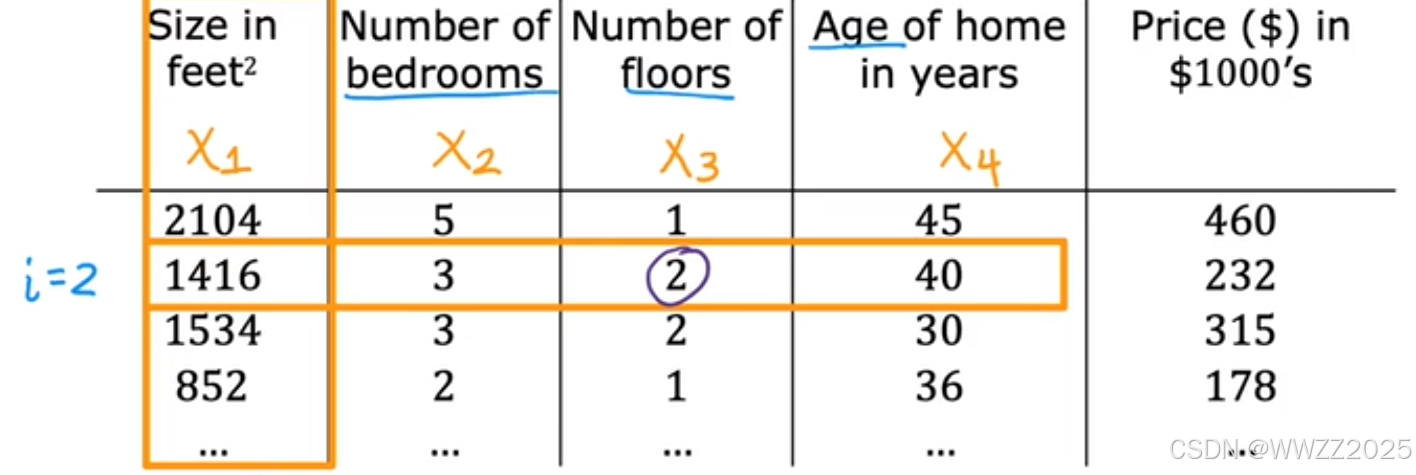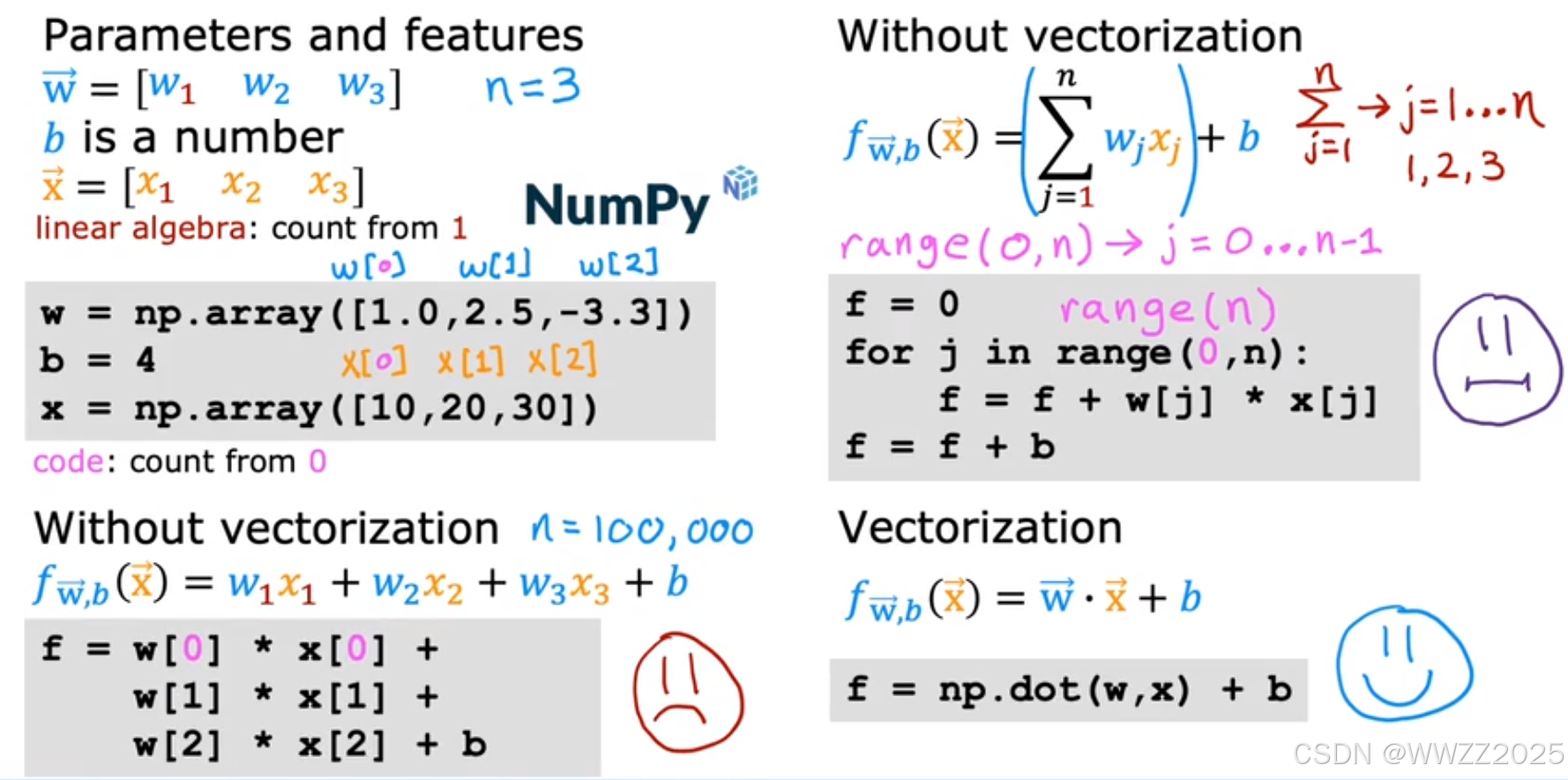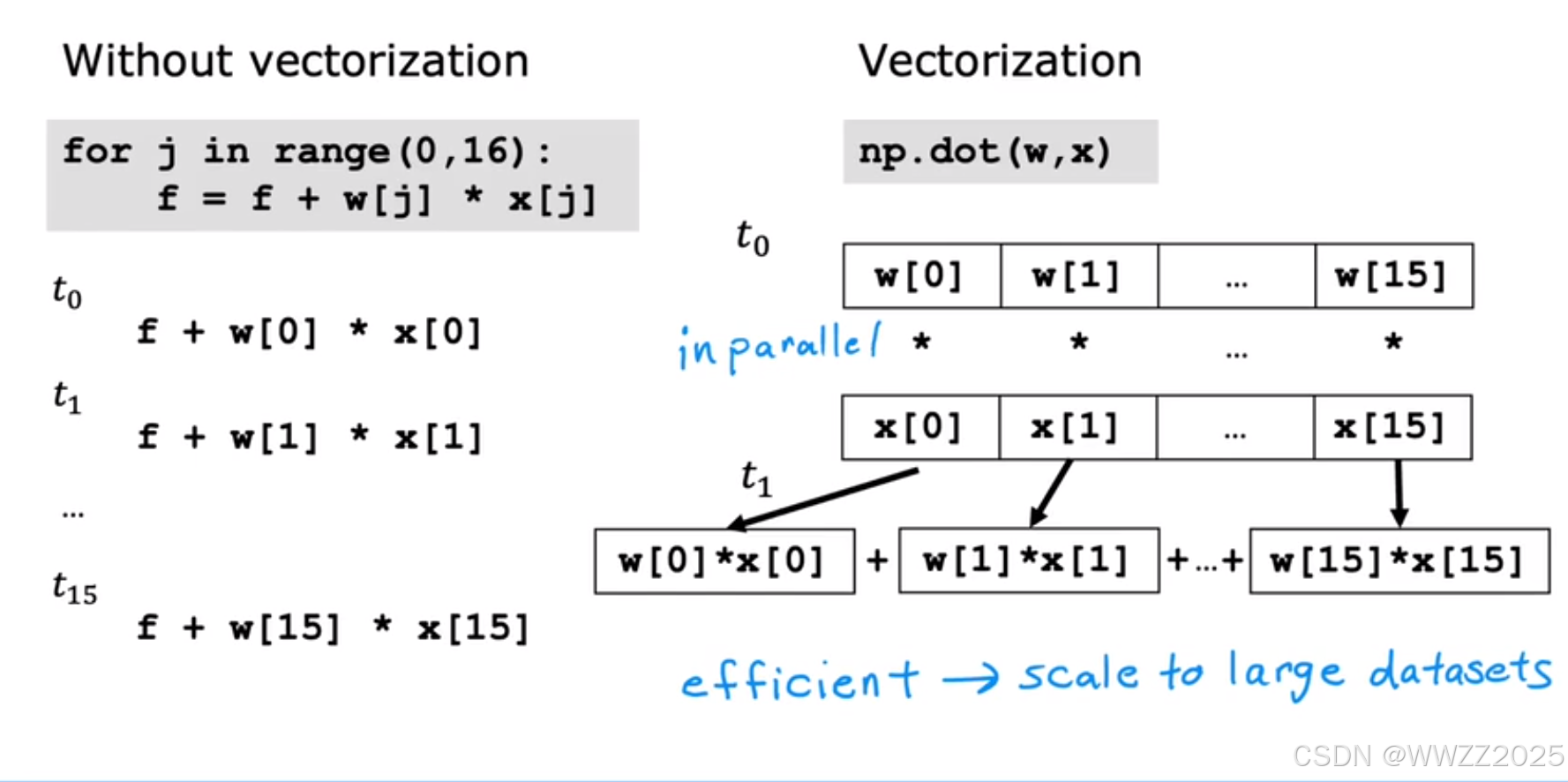目录
1 多元线性回归(Multiple liner regression)
2.4 向量点积运算(dot product multiplies the values)
学习目的:
让线性回归更快、更强大。
1 多元线性回归(Multiple liner regression)
1.1 定义
:第j个特征;
n:特征总数;
:第i个训练样本的所有特征;
:第j个特征第i个训练样本。
多元线性回归(Multiple liner regression):多个输入特征的线性回归模型,表达式
。
2 向量化
2.1 例子
向量化使代码简洁、运行高效。
2.2 代码实现
使用Python编译,调用NumPy包
(1)引入模块/包
import numpy as np # it is an unofficial standard to use np for numpy import time(2)数组创建
代码:
# NumPy routines which allocate memory and fill arrays with value a = np.zeros(4); print(f"np.zeros(4) : a = {a}, a shape = {a.shape}, a data type = {a.dtype}") a = np.zeros((4,)); print(f"np.zeros(4,) : a = {a}, a shape = {a.shape}, a data type = {a.dtype}") a = np.random.random_sample(4); print(f"np.random.random_sample(4): a = {a}, a shape = {a.shape}, a data type = {a.dtype}")输出:
# NumPy routines which allocate memory and fill arrays with value a = np.zeros(4); print(f"np.zeros(4) : a = {a}, a shape = {a.shape}, a data type = {a.dtype}") a = np.zeros((4,)); print(f"np.zeros(4,) : a = {a}, a shape = {a.shape}, a data type = {a.dtype}") a = np.random.random_sample(4); print(f"np.random.random_sample(4): a = {a}, a shape = {a.shape}, a data type = {a.dtype}")
np.zeros(4):创建一个长度为4的数组,所有元素都是0.0(浮点数);
a.shape:数组形状,这里是(4,),表示一维数组长度 4;
a.dtype:数据类型。
2.3 NumPy规则
(1)索引(Indexing)
负的从末尾去找,超限报错。
例子:
#vector indexing operations on 1-D vectors a = np.arange(10) print(a) #access an element print(f"a[2].shape: {a[2].shape} a[2] = {a[2]}, Accessing an element returns a scalar") # access the last element, negative indexes count from the end print(f"a[-1] = {a[-1]}") #indexs must be within the range of the vector or they will produce and error try: c = a[10] except Exception as e: print("The error message you'll see is:") print(e)输出:
[0 1 2 3 4 5 6 7 8 9] a[2].shape: () a[2] = 2, Accessing an element returns a scalar a[-1] = 9 The error message you'll see is: index 10 is out of bounds for axis 0 with size 10(2)切片(Slicing)
a[start : stop : step]start:起始索引,包含起始;
stop:终止索引,不包含终止位;
step:步长,每隔多少取一个。
例子:
#vector slicing operations a = np.arange(10) print(f"a = {a}") # access all elements index 3 and above c = a[3:]; print("a[3:] = ", c) # access all elements below index 3 c = a[:3]; print("a[:3] = ", c) # access all elements c = a[:]; print("a[:] = ", c)输出:
a[3:] = [3 4 5 6 7 8 9] a[:3] = [0 1 2] a[:] = [0 1 2 3 4 5 6 7 8 9]
2.4 向量点积运算(dot product multiplies the values)
代码:
import numpy as np # test 1-D a = np.array([1, 2, 3, 4]) b = np.array([-1, 4, 3, 2]) c = np.dot(a, b) print(f"NumPy 1-D np.dot(a, b) = {c}, np.dot(a, b).shape = {c.shape} ") c = np.dot(b, a) print(f"NumPy 1-D np.dot(b, a) = {c}, np.dot(a, b).shape = {c.shape} ")输出:
# np.dot(a, b).shape = () 此处输出为空,因为np.dot(a, b)是数值,不存在维度说法 NumPy 1-D np.dot(a, b) = 24, np.dot(a, b).shape = () NumPy 1-D np.dot(b, a) = 24, np.dot(a, b).shape = ()
2.5 矩阵创建
代码:
a = np.zeros((1, 5)) print(f"a shape = {a.shape}, a = {a}") a = np.zeros((2, 1)) print(f"a shape = {a.shape}, a = {a}") a = np.random.random_sample((1, 1)) print(f"a shape = {a.shape}, a = {a}")输出:
a = np.zeros((1, 5)) print(f"a shape = {a.shape}, a = {a}") a = np.zeros((2, 1)) print(f"a shape = {a.shape}, a = {a}") a = np.random.random_sample((1, 1)) print(f"a shape = {a.shape}, a = {a}")
2.6 矩阵索引
代码:
#vector indexing operations on matrices """np.arange(6) → 生成一个一维数组 [0, 1, 2, 3, 4, 5] .reshape(-1, 2) → 重新调整形状为 N×2 的矩阵 这里的 -1 表示 自动计算行数,使总元素数量不变。""" a = np.arange(6).reshape(-1, 2) #reshape is a convenient way to create matrices print(f"a.shape: {a.shape}, \na= {a}") #access an element print(f"\na[2,0].shape: {a[2, 0].shape}, a[2,0] = {a[2, 0]}, type(a[2,0]) = {type(a[2, 0])} Accessing an element returns a scalar\n") #access a row print(f"a[2].shape: {a[2].shape}, a[2] = {a[2]}, type(a[2]) = {type(a[2])}")输出:
a.shape: (3, 2), a= [[0 1] [2 3] [4 5]] a[2,0].shape: (), a[2,0] = 4, type(a[2,0]) = <class 'numpy.int64'> Accessing an element returns a scalar a[2].shape: (2,), a[2] = [4 5], type(a[2]) = <class 'numpy.ndarray'>
3 多元线性回归的梯度下降法
一元的详见3.5:
https://blog.youkuaiyun.com/weixin_45728280/article/details/153348420?spm=1001.2014.3001.5501
3.1 定义
参数(Parameters):
,b
模型(Model):
代价函数(Cost function):
梯度下降:
代入后梯度函数:
3.2 梯度函数
def gradient_descent(X, y, w_in, b_in, cost_function, gradient_function, alpha, num_iters): """ Performs batch gradient descent to learn theta. Updates theta by taking num_iters gradient steps with learning rate alpha Args: X (ndarray (m,n)) : Data, m examples with n features y (ndarray (m,)) : target values w_in (ndarray (n,)) : initial model parameters b_in (scalar) : initial model parameter cost_function : function to compute cost gradient_function : function to compute the gradient alpha (float) : Learning rate num_iters (int) : number of iterations to run gradient descent Returns: w (ndarray (n,)) : Updated values of parameters b (scalar) : Updated value of parameter """ # An array to store cost J and w's at each iteration primarily for graphing later J_history = [] w = copy.deepcopy(w_in) #avoid modifying global w within function b = b_in for i in range(num_iters): # Calculate the gradient and update the parameters dj_db,dj_dw = gradient_function(X, y, w, b) ##None # Update Parameters using w, b, alpha and gradient w = w - alpha * dj_dw ##None b = b - alpha * dj_db ##None # Save cost J at each iteration if i<100000: # prevent resource exhaustion J_history.append( cost_function(X, y, w, b)) # Print cost every at intervals 10 times or as many iterations if < 10 if i% math.ceil(num_iters / 10) == 0: print(f"Iteration {i:4d}: Cost {J_history[-1]:8.2f} ") return w, b, J_history #return final w,b and J history for graphing # initialize parameters initial_w = np.zeros_like(w_init) initial_b = 0. # some gradient descent settings iterations = 1000 alpha = 5.0e-7 # run gradient descent w_final, b_final, J_hist = gradient_descent(X_train, y_train, initial_w, initial_b, compute_cost, compute_gradient, alpha, iterations) print(f"b,w found by gradient descent: {b_final:0.2f},{w_final} ") m,_ = X_train.shape for i in range(m): print(f"prediction: {np.dot(X_train[i], w_final) + b_final:0.2f}, target value: {y_train[i]}")输出:
Iteration 0: Cost 2529.46 Iteration 100: Cost 695.99 Iteration 200: Cost 694.92 Iteration 300: Cost 693.86 Iteration 400: Cost 692.81 Iteration 500: Cost 691.77 Iteration 600: Cost 690.73 Iteration 700: Cost 689.71 Iteration 800: Cost 688.70 Iteration 900: Cost 687.69 b,w found by gradient descent: -0.00,[ 0.2 0. -0.01 -0.07] prediction: 426.19, target value: 460 prediction: 286.17, target value: 232 prediction: 171.47, target value: 178
4 正规方程(Normal equation)求解代价函数
采用正规方程可以直接求解w,b,无需使用梯度下降法迭代。
4.1 定义
仅用于线性回归,用于直接求解w,b而不需迭代。
4.2 缺点
(1)无法推广到其他算法;
(2)特征量n很大(>10000)运算很慢

























 1328
1328

 被折叠的 条评论
为什么被折叠?
被折叠的 条评论
为什么被折叠?








